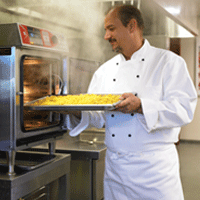An oven should cater to individual needs, rather than just the latest trends
On the surface, choosing the best oven seems easy as pie. For the most part, it’s about finding one with consistent quality and reasonable throughput that saves time. But the category appears to be going through a renaissance these days and, with a bevy of new features and functions available, choosing the right appliance for the job can get complicated.
Whether the problem is size, constant menu changes, or the need to reduce personnel costs and training, different oven technologies answer different functional demands. Workhorses like convection ovens continue to remain strong, but up-and-coming technologies, like combis and accelerated cooking units, are rapidly gaining market share. Even tried-and-true conveyor and deck ovens aren’t one-trick ponies anymore.
While there are a number of factors driving oven investments these days, there’s one that trumps them all. “Ovens are typically real energy hogs, so energy savings is where just about everyone is looking for solutions,” says Randy Speck, national manager for Russell Food Equipment in Vancouver.
But, Dean Landeche, senior vice-president of Marketing for Manitowoc Foodservice’s education and technology centre in New Port Richey, Fla., says that beyond the overarching energy efficiency consideration, there are four other key factors that should go into purchasing decisions. It begins with flexibility. “Whether you’re a quick-service operation or an institution, you need to go through lots of menu changes, so you need something that can do a combination of things and reach across a broad variety of products,” Landeche explains.
Overall quality and consistency is another big consideration, especially for chain operations serving multiple locations. Landeche’s ‘sweet spot’ for both flexibility and quality is combi-ovens. “They’re the most flexible and can deliver the highest quality, because they give you moisture as well as convection.”
Another popular trend is speed, he adds. “It’s all about how quickly an oven can deliver the quality of product while keeping up with demand. Accelerated cooking and/or combined convection/microwave technologies are far faster than traditional convection, so they are terrific choices for front-of-the-house operations like convenience stores, limited-service restaurants or room service in hotels during the off hours.”
System size should also be considered as operators look for good throughput and quality in the smallest footprint possible, which is leading to a growing interest in smaller, higher-speed countertop units.
But, the fastest-growing segment of the category includes accelerated cooking and combi-ovens. The accelerated oven category, in particular, “has grown from nothing, [just] seven years ago, to a very large category, that continues to attract broader acceptance in a variety of operations,” Landeche says. Front-runners in the category include Merrychef and TurboChef, with prices generally ranging between $4,000 and $7,000.
And there has been accelerated adoption of combi-ovens in North America in the last five to 10 years because of their ability to produce a broader range of products, while reducing shrinkage and improving yield. “For large-scale operations, especially, combis win hands down, because you can cook in bulk in a more controlled environment and get consistent results,” Russell’s Speck says.
“We now look at introducing combi-ovens to most of our educational and institutional clients,” says Lisa Bell, principal of Lisa Bell & Associates, a design firm in Surrey, B.C. “While they are a higher cost, they offer better product and greater flexibility.”
With the latest in advanced controls, combis are indeed more flexible and easier to master. A chef can program them with menu specifications, so food quality is consistent and can be replicated across multiple locations. Category leaders include Rational, Alto-Shaam (Combi-therm), Electrolux and Blodgett.
Speaking of automated controls, the big trend in combi-ovens right now is automatic cleaning, Speck adds. “That’s always been a problem, but Rational’s new cleaning system works incredibly well.” Generally speaking, small countertop versions run between $5,000 and $7,000, while larger units, which accommodate roll-in racks, for instance, range from $20,000 to $30,000.
While accelerated cooking and combi-ovens are gaining popularity, don’t discount the tried-and-true workhorses of the trade. Convection ovens remain the number 1 oven of choice and continue to feature new functions to help in food preparation. It’s also the first oven category to be Energy-Star rated — a bonus for energy-conscious operators.
With a starting price of about $1,500, “Convection will always be there because it offers flexibility at low cost,” Speck says. “When the budget isn’t there for combi-ovens, then the standard convection oven is usually the selected unit,” Bell confirms.
The units also perform extremely well, shaving 35 per cent off cooking times, while lowering temperature requirements by 50 degrees, Speck explains. He adds that the Missouri-based Duke ovens rank among the most energy efficient on the market, operating at 20,000 to 40,000 BTUs versus the typical 60,000 to 80,000 BTU range. Other major players in this highly competitive space include Blodgett and Vulcan.
The biggest changes in recent months have been in the area of advanced electronic controls. Some units even have USB thumb drive and wireless communications capabilities to manage menu changes or communicate with staff and/or maintenance workers. In fact, select Garland models offer a range of advanced communications capabilities useful for chain and large institutional operations.
Steam-type cooking, or a “spritzer” oven, is another convection innovation. It is used to improve baking quality (especially of carbohydrate-based items) and help retain moisture in protein products. In short, Garland Canada cites presentation, productivity, efficiency and yield improvements as the winning features of its system.
Of course, with regard to high throughput and guaranteed delivery, conveyor and deck ovens continue to hold their own. Lincoln, Middleby Marshall and Blodgett are cited as brand leaders, with Star and CTX also in the running.
“Conveyors are pure throughput, which makes them great,” Landeche notes. “If you want speed and consistency to handle high-capacity production periods for pizzas, sandwiches and baked items, conveyors offer it all.” A simple conveyor oven, without the bells and whistles, might start between $1,500 and $2,000, but can easily reach $20,000 or more depending on the capacity and number of decks.
The technology focus in recent months has been on energy savings, since conveyor ovens tend to discharge a lot of heat into the kitchen. In response to that trend, the Lincoln Quest model now offers an energy management system that recognizes temperature drops, when the unit is in sleep mode, and adjusts belt speed accordingly.
Another option is the deck oven, a popular choice for smaller, independent pizza and sandwich operations where they can be used to re-thermalize front-counter items. Some units include multiple cooking chambers, which allow operators to set different cooking zones. Vendors include Garland, Middleby Marshall and Bakers Pride. Depending on size and cooking speed, prices range from $4,000 to $7,500 and up.
Whether the need is for speed, efficiency, throughput, quality — or all of the above — oven innovators are keeping pace with operational demands. It’s simply a matter of understanding what’s best for your environment and budget.





















